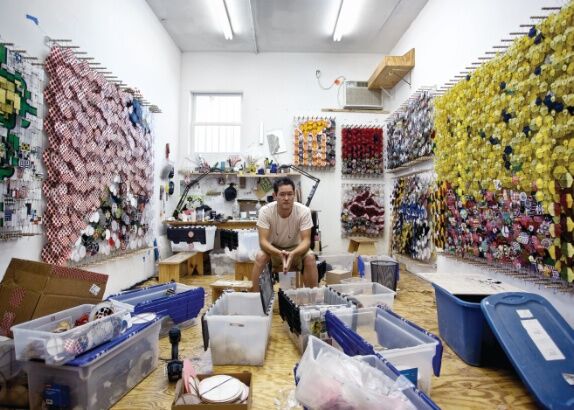
The Kite Runner

Jacob Hashimoto (BFA 1996) was recently the Visiting Artists Program's Distinguished Alumni Lecturer. SAIC student Anjulie Rao (MA 2014) interviewed him about building kites, attending SAIC, and pursuing repetition.
What sparked your initial interest in creating paper kites? Can you talk about your relationship with your Japanese heritage and the artistic practices within, especially as a Japanese American?
Funny enough, I originally started building kites to fly in Grant Park when I was a student at SAIC. I don't really think that the process was consciously based in my ethnic heritage, but I imagine there's some kind of inevitable connection. Thinking about it over the years, I remember that my father used to fly kites a lot when we lived in Pocatello, Idaho. He used to build little, simple diamond-shaped kites and fly them on a hill that overlooked the Idaho State University campus. My father apparently learned the craft from his father; they used to steal chopsticks from the kitchen, split them, and build kites from them. Alternatively, I ended up teaching myself to build kites from books and repetition.
Repetition seems to be an important element in your work. Can you talk about the process of making thousands of individual objects? Is it daunting, meditative, or something else entirely?
I think that it is probably both daunting and meditative in turns...but more than anything, it's just a lot of tedium and toil. Early on, I think that the pure challenge of building some mad number of objects was a significant driving factor in my pursuit of these kinds of projects, but as my studio practice developed over the years, I think that the toil has become something to which I'm pretty resigned. I try not to dwell on it too much as it just makes everything more difficult. That said, I think that the process of building hundreds or thousands or tens of thousands of anything is really tough psychologically; and it has taken years for me to shift my mind into the kind of place where I can work for hours or weeks on a single task without getting really depressed or crazy. I suppose that it's some kind of meditation in the end—a meditation born out of necessity to the fruition of the process.
Why did you choose to study at SAIC? Were there any formative moments, classes, or faculty you can speak of?
I came to SAIC as a transfer student from Carleton College in Minnesota. As I was already in the Midwest, I think that it was a logical, logistical decision for the most part.In short, I realized that I wasn't getting a competitive, comprehensive, or challenging studio education at Carleton and decided to find a program that could address these shortcomings. SAIC seemed to provide that kind of environment. At SAIC, I was faced with hundreds of other art students vying for attention. I was faced with a fluid sort of curriculum and I think that I was pretty adrift until I applied for the advanced painting studios. Advanced painting really saved me at the school as it provided me with a small studio and a more intensive, immersive environment where I could really explore ideas. I think that it also provided a sense of place and safety that was critical to my early development at the school and after. In advanced painting, I worked wit a lot of great professors—Susanne Doremus, Jim Lutes, Ray Yoshida, and Ted Halkin. They were really terrific and greatly encouraging.
You are currently living in Brooklyn; you are from a small town in Colorado, and you studied in Chicago and Minnesota. Has geography affected your work, conceptually, or in your general practice as an artist?
While I was born in Greeley, CO—which is a smallish city—I grew up in Walla Walla, Washington, which is a definitively small town, nestled in wheat fields at the base of a little mountain range. As evidenced in my work, I'm very tied to landscape and I'm sure that my work has shifted and changed as I've moved the studio from city to city. I find it surprising that I've actually lived in big American cities for most of my adult life and for all of my professional life, and so I don't think that it's affected my work very dramatically. I think that nature, as pursued in my work, is generated by this nostalgic longing that separates youth from adulthood—the urban fetishization of the bucolic.
What types of projects are you currently working on? How do you see your work evolving?
I'm working on a lot of shows. I have four shows in five weeks beginning May 11 and I've got to get moving on a lot of the work! I'll be doing a drawing show that opens on May 11 at Studio La Citta in Verona; a solo show that opens at Galerie Forsblom in Helsinki on May 17; a show of a new installation at Schauwerk near Stuttgart, Germany; and a show at the Bildmuseet in Umeå Sweden. After those projects, I'm coming back to the states to install a large sculpture commissioned as part of the federal government's Art in Architecture program. It's a hanging installation for the two new atria in the General Services Administration's newly renovated building. It's going to be a very busy year.
